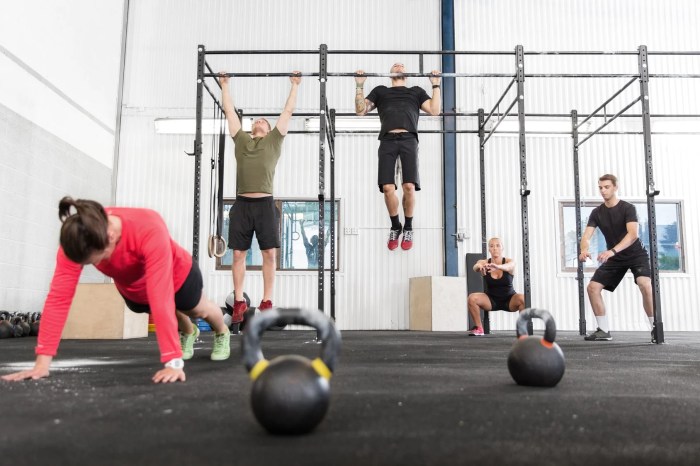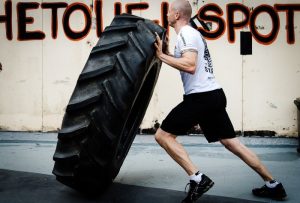
Ever dreamt of unleashing your inner superhero? Forget capes and tights; CrossFit training programs are your secret weapon. Prepare for a fitness journey that’s less “gentle yoga flow” and more “controlled explosion of awesomeness.” We’re diving headfirst into the world of burpees, box jumps, and kettlebell swings – and trust us, it’s going to be epic. Get ready to discover how CrossFit can transform you from couch potato to certified fitness ninja (or at least, a much fitter version of yourself!).
This guide unravels the mysteries of CrossFit, from understanding its core principles and diverse workout styles to mastering scaling techniques and fueling your body for peak performance. We’ll tackle everything from crafting the perfect workout plan to navigating the sometimes-daunting world of choosing a CrossFit gym. Think of us as your personal CrossFit Sherpas, guiding you safely (and hilariously) to the summit of fitness Mount Awesome.
Introduction to CrossFit Training Programs

CrossFit: It’s not just a workout; it’s a lifestyle choice…or at least that’s what the super-fit people wearing suspiciously pristine workout gear will tell you. But seriously, CrossFit is a high-intensity fitness program that combines elements of weightlifting, gymnastics, and metabolic conditioning. Think of it as a constantly varied, high-intensity workout designed to make you incredibly, ridiculously fit.
Prepare for some serious sweat.CrossFit’s fundamental principles revolve around constantly varied functional movements performed at high intensity. “Constantly varied” means you’re never doing the same workout twice (unless you’re a masochist), and “functional movements” refer to exercises that mimic real-world actions, like lifting, pushing, pulling, and squatting. The high intensity? Well, that’s the part that will leave you gasping for air and questioning your life choices…in a good way, eventually.
CrossFit Training Methodologies
CrossFit employs a variety of training methodologies to achieve its goals of increased strength, endurance, and overall fitness. These methods are designed to challenge your body in different ways, preventing plateaus and keeping things interesting (or terrifying, depending on your perspective). Some common methodologies include:
- Strength Training: Think Olympic weightlifting, powerlifting, and other strength-building exercises. This builds the foundation for all other CrossFit activities.
- Metabolic Conditioning (MetCon): These workouts are designed to improve your cardiovascular and respiratory systems. Expect a lot of burpees, running, rowing, and other exercises that will leave you breathless.
- Gymnastics: Handstand push-ups, muscle-ups, pull-ups – the stuff of fitness legends (or nightmares, depending on your current fitness level). This improves body control, flexibility, and strength.
Benefits of CrossFit Compared to Other Fitness Programs
CrossFit offers a unique blend of benefits that surpass many other fitness programs. Its versatility and high-intensity nature lead to significant improvements in strength, endurance, flexibility, and overall fitness. Unlike some programs that focus solely on one aspect of fitness, CrossFit provides a holistic approach, making you stronger, faster, and more resilient. The community aspect, often highlighted by CrossFit enthusiasts, also plays a role in boosting motivation and adherence to the program.
Comparison of CrossFit with Other Workout Routines
This table compares CrossFit with other popular workout routines, highlighting key differences in intensity, muscle groups targeted, and time commitment. Remember, these are general comparisons and individual experiences may vary.
| Type | Intensity | Muscle Groups Targeted | Time Commitment |
|---|---|---|---|
| CrossFit | Very High | Full Body | 60-90 minutes per session |
| Weightlifting | High to Moderate | Specific muscle groups | 60-90 minutes per session |
| HIIT (High-Intensity Interval Training) | High | Full Body | 20-45 minutes per session |
| Yoga | Low to Moderate | Full Body (focus on flexibility and balance) | 45-90 minutes per session |
Types of CrossFit Workouts
So, you’ve decided to brave the world of CrossFit – welcome to the jungle! Prepare for a fitness experience unlike any other, a thrilling blend of high-intensity interval training, Olympic weightlifting, gymnastics, and more. This isn’t your grandma’s aerobics class; expect sweat, maybe some tears (of joy, mostly), and a newfound respect for your own physical capabilities. Let’s delve into the delicious chaos that awaits.CrossFit workouts, lovingly known as WODs (Workout Of the Day), come in many shapes and sizes, each designed to challenge you in different ways.
We’ll explore the main categories, providing examples to whet your appetite (and maybe make you slightly apprehensive – in a good way!).
Workout of the Day (WOD) Variations
WODs are the heart and soul of CrossFit. They’re typically high-intensity, full-body workouts designed to improve your overall fitness. The beauty (and the terror) lies in their variability. No two days are ever exactly alike, keeping your body guessing and preventing plateaus. WODs can range from short, brutal bursts of intense effort to longer, more endurance-focused challenges.
They frequently combine elements of strength training, metabolic conditioning, and gymnastics.For example, a typical WOD might involve a combination of barbell movements like squats and deadlifts, followed by a metabolic conditioning component like burpees and kettlebell swings, all capped off with some pull-ups or handstand practice, if you’re feeling particularly brave. The intensity level varies drastically depending on the prescribed movements, reps, sets, and time constraints.
A high-intensity WOD might have you gasping for air after just 10 minutes, while a lower-intensity WOD might allow for more controlled movements and longer rest periods.
Strength Training
This is where you’ll build that impressive foundation of strength. Think heavy weights, lower reps, and a focus on proper form. Strength training in CrossFit isn’t just about lifting the heaviest weight possible; it’s about building a solid base to support your other workouts. Exercises often include squats, deadlifts, bench presses, overhead presses, and rows. These exercises are performed with a focus on proper form and progressive overload, gradually increasing the weight or reps over time.
A sample strength training workout might involve 3 sets of 5 reps of back squats, followed by 3 sets of 8 reps of bench presses.
Olympic Lifting
This is the artistry of CrossFit weightlifting. Olympic lifts, like the snatch and the clean and jerk, are incredibly dynamic and technically demanding movements that require both explosive power and precise technique. Mastering these movements takes time and dedication, but the rewards are immense – increased power, improved coordination, and a whole lot of bragging rights. These movements are generally performed with lighter weights than strength training, focusing on speed and technique rather than pure strength.
Gymnastics
Think handstand push-ups, muscle-ups, pull-ups, dips, and ring work. This component focuses on bodyweight movements, building strength, flexibility, and control. Gymnastics workouts challenge your body in unique ways, improving mobility, stability, and coordination. A beginner might start with assisted pull-ups, progressing to unassisted pull-ups over time.
Sample Beginner CrossFit Workout Plan
Remember, proper form is paramount! If you’re unsure about any exercise, ask a coach for guidance. Never sacrifice form for speed or weight.
This plan is a suggestion and should be adjusted based on your individual fitness level and capabilities. Always consult with a healthcare professional before starting any new workout routine.
- Monday: Strength
- Squats: 3 sets of 8 reps
- Push-ups: 3 sets of as many reps as possible (AMRAP)
- Rows: 3 sets of 8 reps
- Rest: 60 seconds between sets
- Tuesday: Metabolic Conditioning
- 500m Row: 1 round
- 20 Burpees
- 10 Kettlebell Swings (per side)
- Rest: 60 seconds between rounds. Repeat 3 times.
- Wednesday: Rest or Active Recovery (light cardio, stretching)
- Thursday: Strength
- Deadlifts: 1 set of 5 reps, 1 set of 3 reps, 1 set of 1 rep
- Overhead Press: 3 sets of 8 reps
- Plank: 3 sets, hold for 30 seconds
- Rest: 60 seconds between sets
- Friday: Metabolic Conditioning
- 400m Run: 1 round
- 15 Burpees
- 10 Box Jumps
- Rest: 60 seconds between rounds. Repeat 3 times.
- Weekend: Rest or Active Recovery (longer cardio, yoga, stretching)
Scaling and Modification of CrossFit Workouts
CrossFit, with its high-intensity workouts, isn’t a one-size-fits-all affair. Think of it like a tailor-made suit – you wouldn’t wear a suit designed for a linebacker if you’re a jockey, would you? Similarly, scaling workouts is crucial for ensuring safety, maximizing progress, and preventing injuries. It’s not about making the workout “easier,” but rather adapting it to your current fitness level so you can reap the benefits without risking a trip to the chiropractor.Scaling and modifying CrossFit workouts is about finding the sweet spot between challenge and capability.
It allows individuals of all fitness levels – from seasoned athletes to complete beginners – to participate and progress safely. Proper scaling ensures that everyone gets a good workout, regardless of their experience or physical limitations. Remember, progress, not perfection, is the name of the game!
Scaling Techniques for Various Exercises
Scaling is about adjusting the intensity or difficulty of an exercise to match your capabilities. This can involve modifying the weight, reps, sets, or even the exercise itself. A variety of techniques are available, allowing for personalized adjustments.
- Weight Reduction: Simply using lighter weights allows for maintaining the same movement pattern and technique without compromising form due to fatigue. For example, if the prescribed workout calls for a 135-pound barbell back squat, someone might scale it down to 95 pounds or even just the barbell itself (approximately 45 pounds). This preserves the movement’s integrity and allows for proper practice.
- Rep Scheme Modification: Instead of aiming for high reps with a heavier weight, one can perform fewer repetitions with the same weight or a slightly heavier weight, effectively maintaining the intensity. For instance, instead of 15 reps of deadlifts, one could scale down to 10 reps, or even 5 reps with heavier weight, depending on individual strength.
- Exercise Substitution: Sometimes, an exercise might be too challenging or impossible due to injury or limitations. Scaling in this case means replacing the exercise with a similar one that targets the same muscle groups but reduces stress on the injured area. A box jump could be replaced with step-ups, for instance, or handstand push-ups could be substituted with pike push-ups against a wall.
- Time Modification: Instead of completing a workout within a specific time limit, one can extend the time allowed, focusing on maintaining good form and completing the prescribed movements. This is especially helpful for high-intensity metabolic conditioning (METCON) workouts.
Modifications for Injuries and Limitations
Injuries and physical limitations are common, and CrossFit’s adaptable nature allows for accommodations. Scaling should be approached thoughtfully and individually, considering specific restrictions.
- Knee Injuries: Box jumps might be replaced with step-ups, and deep squats might be modified to partial squats or goblet squats. Avoiding high-impact movements is key.
- Shoulder Injuries: Overhead presses can be scaled down to lighter weights or replaced with dumbbell lateral raises or front raises. Strict pull-ups can be substituted with assisted pull-ups or ring rows.
- Back Injuries: Deadlifts might be modified to Romanian deadlifts (RDLs) to reduce spinal stress, or replaced with good mornings. Heavy squats should be avoided, possibly opting for lighter goblet squats or box squats.
Best Practices for Safe and Effective Scaling
Scaling isn’t about cheating; it’s about smart training. Following best practices ensures safety and progress.
- Listen to Your Body: Pain is a warning sign. Don’t push through pain; scale down or modify the exercise. This prevents further injury and ensures your body recovers properly.
- Consult a Professional: If you have pre-existing injuries or conditions, consult with a physical therapist or doctor before starting a CrossFit program. They can provide guidance on appropriate modifications and exercises.
- Proper Form is Paramount: Always prioritize proper form over the weight or number of reps. Scaling down to maintain good form is always preferable to compromising form for heavier weights or more reps.
- Progressive Overload: Gradually increase the intensity or difficulty of your workouts over time. This ensures continuous progress and avoids plateaus.
Nutrition and CrossFit
Fueling your body for CrossFit is like prepping a rocket for launch – you need the right kind of fuel to achieve maximum thrust (and avoid spectacular, fiery explosions). Proper nutrition isn’t just about looking good in your workout gear; it’s the cornerstone of consistent progress, injury prevention, and feeling fantastic while you’re crushing those WODs. Think of your body as a high-performance machine; you wouldn’t put regular unleaded in a Ferrari, would you?Proper nutrition significantly impacts CrossFit performance.
Sufficient calorie intake supports intense training, ensuring adequate energy for workouts and recovery. A balanced diet rich in macronutrients (protein, carbohydrates, and fats) and micronutrients (vitamins and minerals) optimizes muscle growth, repair, and overall health. Ignoring nutrition is like trying to build a castle out of jelly – it’s just not going to stand up to the pressure.
Sample Meal Plan for a CrossFit Athlete
A sample meal plan needs to be tailored to individual needs, considering factors like training volume, body composition goals, and personal preferences. However, this plan provides a general framework for a CrossFit athlete consuming roughly 2500-3000 calories daily, focusing on whole, unprocessed foods. Remember to adjust portion sizes based on your individual caloric needs.
- Breakfast (7:00 AM): Oatmeal with berries and nuts, a scoop of protein powder, and a cup of black coffee. This provides sustained energy release and essential nutrients.
- Mid-Morning Snack (10:00 AM): Greek yogurt with fruit and a handful of almonds. A good source of protein and healthy fats to keep you going until lunch.
- Lunch (1:00 PM): Large salad with grilled chicken or fish, quinoa, and plenty of vegetables. A balanced meal with lean protein, complex carbohydrates, and fiber.
- Pre-Workout Snack (4:00 PM): A banana with peanut butter. Easily digestible carbohydrates for quick energy before a workout.
- Post-Workout Snack (6:00 PM): Protein shake with berries and a small amount of oats. This helps with muscle recovery and replenishes glycogen stores.
- Dinner (8:00 PM): Lean protein source (e.g., chicken breast, salmon, or tofu) with roasted vegetables and sweet potato. Provides essential nutrients for muscle repair and overall health.
Hydration and Supplementation in CrossFit Training
Hydration is paramount, especially during intense workouts. Dehydration can lead to decreased performance, fatigue, and even heat exhaustion. Aim to drink plenty of water throughout the day, especially before, during, and after training. Consider electrolyte drinks during longer or more intense sessions to replace lost minerals.Supplementation should be approached cautiously. While some supplements, like creatine and protein powder, can be beneficial for certain athletes, they are not essential for everyone.
Before taking any supplements, consult with a healthcare professional or registered dietitian to determine their suitability for your individual needs and to avoid potential interactions with other medications or supplements.
Dietary Approaches for CrossFit Athletes
Several dietary approaches can support CrossFit training, including the Paleo diet, the Zone diet, and a flexible dieting approach.The Paleo diet focuses on whole, unprocessed foods similar to what our ancestors ate. The Zone diet emphasizes balanced macronutrient ratios to regulate blood sugar and insulin levels. A flexible dieting approach allows for greater flexibility in food choices, focusing on hitting daily macronutrient and micronutrient targets.
The best approach depends on individual preferences, goals, and tolerance. For example, a highly disciplined athlete might thrive on the strict structure of the Zone diet, while a busy individual might find a flexible approach more sustainable. The key is consistency and finding a dietary pattern that works for your lifestyle and training regime.
Recovery and Rest in CrossFit
CrossFit, with its high-intensity workouts, demands more than just sweat and grit; it demands respect for the recovery process. Think of your body as a finely tuned engine – push it too hard without proper maintenance, and you’ll end up with a smoking wreck (and a very sore you). Rest and recovery aren’t optional extras; they’re the secret sauce to maximizing gains, preventing injuries, and ensuring you’re back in the box, ready to crush it, workout after workout.Rest and recovery are crucial for preventing injuries and stimulating muscle growth.
Without adequate rest, your muscles can’t repair themselves after intense training, leading to micro-tears that accumulate and eventually manifest as full-blown injuries. Moreover, muscle growth (that glorious hypertrophy we all crave) happens during rest, not during the workout itself. Think of it like this: the workout is the stimulus, but rest is where the magic happens. Your body rebuilds stronger, bigger, and better.
The Importance of Sleep
Sleep is arguably the most important aspect of recovery. During deep sleep, your body releases growth hormone, crucial for muscle repair and growth. Aim for 7-9 hours of quality sleep per night. Consider optimizing your sleep hygiene: maintain a consistent sleep schedule, create a relaxing bedtime routine, and ensure your bedroom is dark, quiet, and cool. Ignoring sleep is like ignoring the instruction manual for your body.
Active Recovery Methods
Active recovery involves low-intensity movement that promotes blood flow and reduces muscle soreness. Think leisurely walks, light cycling, or swimming. These activities help flush out metabolic waste products and improve circulation, speeding up the recovery process. Active recovery isn’t about pushing yourself; it’s about gently moving your body to aid in recovery.
Passive Recovery Methods
Passive recovery involves techniques that help your body relax and recover without physical activity. Foam rolling, for instance, helps to release muscle tension and improve flexibility. Other passive recovery methods include stretching, ice baths (for reducing inflammation), and massage therapy. These techniques can be especially beneficial after particularly grueling workouts.
Recognizing and Preventing Overtraining
Overtraining is a serious issue, characterized by persistent fatigue, decreased performance, increased resting heart rate, and mood changes (think irritability and even depression). Prevention is key: prioritize sleep, listen to your body (rest when needed), and incorporate adequate rest days into your training schedule. Don’t be a hero; smart training is better than heroic failure.
A Sample Weekly Recovery Plan
This plan incorporates both active and passive recovery techniques, tailored to a typical CrossFit training week. Remember to adjust it based on your individual needs and workout intensity.
| Day | Activity | Duration | Focus |
|---|---|---|---|
| Monday | Light Jog/Walk | 30 minutes | Active Recovery |
| Tuesday | Rest | N/A | Passive Recovery |
| Wednesday | Foam Rolling & Stretching | 20 minutes | Passive Recovery |
| Thursday | Light Swimming | 45 minutes | Active Recovery |
| Friday | Rest | N/A | Passive Recovery |
| Saturday | CrossFit Workout | 60-90 minutes | High Intensity |
| Sunday | Rest or very light activity (yoga) | Variable | Passive/Active Recovery |
The Role of CrossFit in Health and Fitness

CrossFit, with its blend of high-intensity interval training (HIIT), Olympic weightlifting, gymnastics, and metabolic conditioning, isn’t just a workout; it’s a comprehensive approach to improving overall health and fitness. While it’s undeniably challenging, the results, when approached correctly, can be transformative, impacting various aspects of your physical and mental well-being. Let’s delve into the specifics.
Cardiovascular Health Improvements
CrossFit’s varied workouts consistently elevate your heart rate, boosting cardiovascular fitness. The combination of short bursts of intense activity followed by brief recovery periods improves both aerobic and anaerobic capacity. This translates to a stronger heart, lower resting heart rate, improved blood pressure, and enhanced endurance – all crucial for a healthy cardiovascular system. Imagine a workout involving rowing, burpees, and kettlebell swings – your heart is working hard throughout, building strength and efficiency.
Studies have shown that consistent CrossFit participation leads to significant improvements in VO2 max, a key indicator of cardiovascular fitness.
Strength and Muscle Development
The emphasis on functional movements and weightlifting in CrossFit leads to significant strength gains and muscle development. Exercises like squats, deadlifts, and overhead presses work multiple muscle groups simultaneously, building overall strength and power. Furthermore, the constantly varied nature of CrossFit programming prevents plateaus and ensures continued muscle growth. Think of the muscle hypertrophy resulting from consistently challenging your body with heavy lifts and challenging bodyweight movements.
This not only improves physical performance but also contributes to increased bone density, reducing the risk of osteoporosis.
Weight Management and Body Composition
CrossFit’s high-intensity nature burns a significant number of calories in a relatively short amount of time. Combined with the muscle building aspect, this leads to improved body composition – increased lean muscle mass and decreased body fat. The metabolic boost from CrossFit also continues even after the workout, contributing to increased fat burning throughout the day. For example, a challenging CrossFit workout might burn 500-800 calories, and the increased metabolism can lead to further calorie expenditure throughout the day, facilitating weight loss or maintenance.
The results, however, are highly dependent on individual factors and nutritional habits.
Overall Health and Well-being
Beyond the physical benefits, CrossFit contributes to improved mental well-being. The challenging workouts release endorphins, reducing stress and improving mood. The community aspect of many CrossFit boxes fosters social connection and support, which is beneficial for mental health. Furthermore, the consistent dedication required for CrossFit instills discipline and self-confidence. Improved sleep quality is also a common benefit, as regular physical activity contributes to better sleep patterns.
Studies show a correlation between CrossFit participation and reduced risk of chronic diseases like type 2 diabetes and cardiovascular disease, though more research is needed to establish direct causation. The holistic approach to fitness, encompassing physical activity, nutrition, and community, contributes significantly to overall health and well-being.
Common CrossFit Injuries and Prevention
CrossFit, with its high-intensity workouts and varied movements, can be incredibly rewarding, but it also carries an increased risk of injury compared to less demanding forms of exercise. Understanding common injury patterns and implementing proactive prevention strategies is crucial for enjoying a long and healthy CrossFit journey. This section will delve into the most frequent injuries, their root causes, and effective methods for prevention and rehabilitation.
Common CrossFit Injuries
Many CrossFit injuries stem from the combination of high intensity, complex movements, and the potential for improper form. The most frequently reported injuries include shoulder impingement, lower back pain, knee injuries (like ACL tears or meniscus damage), wrist issues (especially sprains and fractures), and strains or tears in the muscles of the hips, hamstrings, and groin. These injuries aren’t inevitable, however; many are preventable with careful attention to detail.
Causes of CrossFit Injuries
The causes of these injuries are multifaceted. Overtraining, insufficient warm-up, poor technique, inadequate recovery, and scaling workouts inappropriately are all significant contributors. For instance, rushing through a complex movement like a snatch or clean can lead to shoulder impingement due to improper joint mechanics. Similarly, neglecting adequate warm-up can leave muscles unprepared for the demands of the workout, increasing the risk of strains or tears.
Ignoring your body’s signals – pushing through pain – is a major risk factor for serious injury.
Injury Prevention Strategies
Preventing CrossFit injuries requires a holistic approach. This begins with a comprehensive warm-up that prepares both the body and mind for the workout ahead. This should include dynamic stretches like arm circles, leg swings, and torso twists, followed by lighter versions of the movements to be performed in the workout. Maintaining proper form during each exercise is paramount.
This might involve slowing down the movement, reducing the weight, or focusing on quality over quantity. Adequate rest and recovery between workouts is essential to allow the body to repair and rebuild. This includes sufficient sleep, proper nutrition, and potentially incorporating active recovery methods like light cardio or yoga.
Proper Form and Technique
Proper form is the cornerstone of injury prevention. Investing time in learning correct technique from experienced coaches is invaluable. Video analysis of your movements can help identify subtle flaws that might contribute to injury. Regularly review and refine your technique, even for exercises you feel comfortable performing. Consider working with a physical therapist or athletic trainer to address any existing imbalances or movement compensations.
Warm-up and Cool-down Techniques
A thorough warm-up should always precede a CrossFit workout. This shouldn’t be a rushed affair; it should gradually increase your heart rate and prepare your muscles for the work ahead. A dynamic warm-up, focusing on movements that mimic those in the workout, is more effective than static stretching before exercise. A cool-down, incorporating static stretches to improve flexibility and reduce muscle soreness, is equally important after each session.
Rehabilitation Methods for Common CrossFit Injuries
Rehabilitation for CrossFit injuries often involves a combination of rest, physical therapy, and targeted exercises. Physical therapy can help restore range of motion, strength, and stability. Specific exercises, tailored to the individual injury, will help rebuild strength and improve function. In some cases, surgery might be necessary, but conservative management is often the preferred approach. Early intervention is key to a successful rehabilitation process.
Patience and consistency are essential; returning to training too soon can lead to re-injury.
Finding and Choosing a CrossFit Box
So, you’ve decided to unleash your inner beast and join the world of CrossFit. Fantastic! But before you leap into a box filled with kettlebells and burpees, choosing the right gym is crucial. Think of it like choosing a life partner – you want someone (or a gym, in this case) who’s going to challenge you, support you, and maybe not leave you with a lingering smell of sweat for the rest of the day.Finding the perfect CrossFit box requires careful consideration of several key factors.
Ignoring these could lead to anything from subpar coaching to injuries, or worse – a serious case of gym-induced regret. This section will help you navigate the treacherous waters of CrossFit gym selection and emerge victorious, ready to conquer WODs with confidence.
Coaching Quality
The quality of coaching is paramount. A good coach isn’t just someone who can shout motivational phrases (though that’s a plus!). They should possess a deep understanding of CrossFit methodology, proper form, and scaling techniques. Look for coaches who prioritize safety, provide individualized attention, and can explain the “why” behind the workout, not just the “what.” A coach who demonstrates a genuine interest in your progress and corrects your form diligently is a keeper.
Imagine a coach who meticulously explains the nuances of a snatch, ensuring you’re not just lifting weights but mastering the technique, reducing your risk of injury. That’s the gold standard.
Community Atmosphere
CrossFit is as much about community as it is about fitness. Visit potential boxes at different times of day to gauge the atmosphere. Is it supportive and encouraging, or competitive and intimidating? Do members seem engaged and happy, or stressed and grumpy? A strong sense of camaraderie can significantly enhance your experience and motivation.
Picture this: a box where everyone cheers each other on, regardless of fitness level, where newcomers feel welcomed and supported, and where shared post-WOD protein shakes are a regular occurrence. That’s a community you want to be a part of.
Equipment and Facilities
While a pristine facility isn’t everything, adequate equipment and a clean, well-maintained gym are essential. Check for a variety of equipment to ensure they can accommodate different workouts and skill levels. Sufficient space, clean bathrooms, and a functional ventilation system are also crucial for a pleasant workout experience. Imagine a gym with gleaming barbells, perfectly organized storage, and enough space to avoid accidental collisions during burpees.
That’s a gym that cares about its members’ well-being and experience.
Questions to Ask Potential CrossFit Coaches
Before committing to a CrossFit box, it’s essential to gain a clear understanding of the gym’s approach to safety, coaching, and programming. A thorough discussion with the coaches will provide valuable insights into their expertise and commitment to their members’ well-being.
Checklist for Evaluating Different CrossFit Gyms
Before you sign up, take a moment to carefully assess each CrossFit box using this checklist. This will help you make an informed decision and find the perfect fit for your fitness journey.
- Coaching Credentials: Are the coaches certified and experienced?
- Class Sizes: Are class sizes manageable, allowing for individualized attention?
- Safety Protocols: Does the gym have clear safety procedures and emergency plans?
- Equipment and Facilities: Is the equipment well-maintained and in good condition? Is the facility clean and well-ventilated?
- Community Atmosphere: Does the gym foster a supportive and inclusive environment?
- Programming: Does the programming cater to different fitness levels and goals?
- Pricing and Membership Options: Are the prices reasonable and are there different membership options available?
- Trial Class: Does the gym offer a trial class to allow you to experience the environment before committing?
- Location and Convenience: Is the gym conveniently located and accessible?
End of Discussion
So, there you have it – a whirlwind tour through the exhilarating world of CrossFit training programs! Remember, CrossFit isn’t just about grueling workouts; it’s about building a stronger, healthier you, both physically and mentally. Embrace the challenge, celebrate the small victories (and the big ones!), and remember to listen to your body. Now go forth and conquer those WODs! And maybe treat yourself to a protein shake afterward.
You deserve it.
Popular Questions
What’s the best way to start CrossFit if I’m a complete beginner?
Start slow! Find a reputable CrossFit box that offers beginner programs and always listen to your coach. Don’t be afraid to scale exercises down; modification is key to avoiding injury and building a solid foundation.
How often should I do CrossFit?
That depends on your fitness level and goals. Beginners might start with 2-3 sessions a week, while more experienced athletes might train more frequently. Remember to incorporate rest days for recovery.
Is CrossFit safe?
CrossFit can be safe when done correctly with proper coaching and scaling. The risk of injury is present in any form of exercise, but following good technique and listening to your body minimizes the risks.
Do I need special equipment for CrossFit?
Most CrossFit boxes provide all the necessary equipment. However, you might want to invest in comfortable workout clothes and supportive shoes.
How much does CrossFit cost?
The cost varies depending on the gym and location. Expect to pay a monthly membership fee, which usually includes access to classes and equipment.





